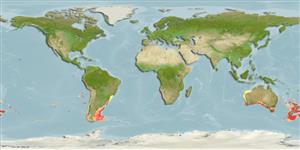>
Gadiformes (Cods) >
Macruronidae (Blue grenadiers)
Etymology: Macruronus: Greek, makros = great + Greek, onos = hake.
Environment: milieu / climate zone / depth range / distribution range
экология
морской; солоноватоводный донно-пелагический; мигрирует в океане; пределы глубины 0 - 1000 m (Ref. 26566), usually 200 - 700 m (Ref. 9563). Subtropical; 15°S - 55°S, 111°E - 173°W (Ref. 58452)
Southwest Pacific: New Zealand and southern Australia.
Length at first maturity / Size / Вес / Возраст
Maturity: Lm 67.5, range 65 - 70 cm
Max length : 120 cm TL самец/пол неопределен; (Ref. 1371); 130.0 cm TL (female); common length : 80.0 cm TL самец/пол неопределен; (Ref. 1371); наибольший вес (опубликованные данные): 1.5 kg (Ref. 1371); наибольший вес (опубликованные данные): 1.5 kg; наибольший возраст (опубликованны данные): 25 годы (Ref. 6390)
Краткое описание
определительные ключи | морфология | морфометрия
колючие лучи спинного плавника (общее число) : 12 - 13; членистые (мягкие) лучи спинного плавника (общее число) : 96 - 106; колючие лучи анального плавника: 0; членистые (мягкие) лучи анального плавника: 89 - 93; позвонки: 78 - 81. Dorsal surface silvery, with a purple or blue-green tinge; plank and belly silvery; fins darker. Body very elongate and compressed with a tapering tail, dorsal and anal fins confluent with the caudal fin (Ref. 33856).
Appear to live usually on or near the bottom, but may occasionally move up into mid-waters. Large adult fish generally occur deeper than 400 m, while juveniles may be found in shallower water (Ref. 9072), more commonly found in large estuaries and bays, and may even enter freshwaters (Ref. 1371). Juvenile specimens and especially adults belonging to the American subspecies, have been caught from the coastal zone to 110 m (Ref. 58452). Form schools. Feed primarily on lantern fishes. In New Zealand, it feeds in midwater on small fish, crustaceans and squid. Oviparous, spawn 1 million eggs on the average which are released all at one time (Ref. 6390). Utilized fresh and frozen; can be steamed, fried, cooked in microwave and baked (Ref. 9988).
Female blue grenadier produce about 1 million eggs on average, which are all released at once (Ref. 6390).
Cohen, D.M., T. Inada, T. Iwamoto and N. Scialabba, 1990. FAO species catalogue. Vol. 10. Gadiform fishes of the world (Order Gadiformes). An annotated and illustrated catalogue of cods, hakes, grenadiers and other gadiform fishes known to date. FAO Fish. Synop. 125(10). Rome: FAO. 442 p. (Ref. 1371)
Статус Красного Списка МСОП (Ref. 130435: Version 2024-1)
Угроза для людей
Harmless
Использование человеком
рыболовство: важный объект промысла
дополнительная информация
инструменты
Специальные отчеты
Скачать в формате XML
ресурсы в Интернет
Estimates based on models
Preferred temperature (Ref.
123201): 5.8 - 12.5, mean 8 °C (based on 300 cells).
Phylogenetic diversity index (Ref.
82804): PD
50 = 0.5625 [Uniqueness, from 0.5 = low to 2.0 = high].
Bayesian length-weight: a=0.00389 (0.00221 - 0.00684), b=2.97 (2.80 - 3.14), in cm total length, based on LWR estimates for this species & (Sub)family-body (Ref.
93245).
Trophic level (Ref.
69278): 4.5 ±0.2 se; based on diet studies.
Generation time: 6.1 (5.2 - 8.9) years. Estimated as median ln(3)/K based on 18
growth studies.
устойчивость к внешним воздействиям (Ref.
120179): низкий, минимальное время удвоения популяции 4.5-14 лет (K=0.12-0.2; tm=3-7; tmax=25; Fec = 1,000,000).
Prior r = 0.29, 95% CL = 0.19 - 0.44, Based on 3 full stock assessments.
Fishing Vulnerability (Ref.
59153): High to very high vulnerability (66 of 100).
Climate Vulnerability (Ref.
125649): High vulnerability (61 of 100).
Nutrients (Ref.
124155): Calcium = 26.4 [12.3, 56.9] mg/100g; Iron = 0.629 [0.299, 1.299] mg/100g; Protein = 17.7 [15.5, 19.8] %; Omega3 = 0.224 [0.105, 0.456] g/100g; Selenium = 62.1 [26.1, 122.9] μg/100g; VitaminA = 17.2 [5.4, 54.1] μg/100g; Zinc = 0.541 [0.348, 0.866] mg/100g (wet weight); based on
nutrient studies.
